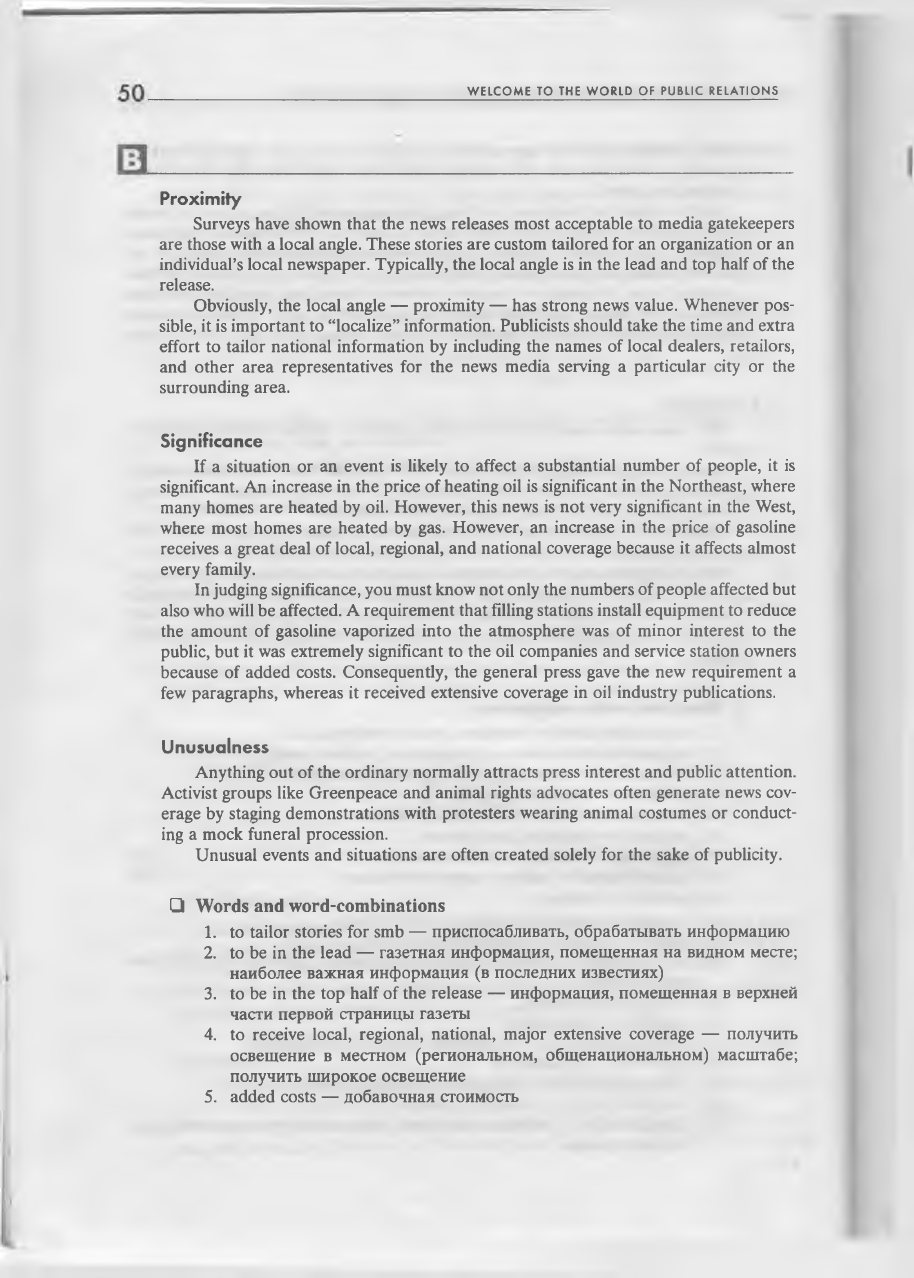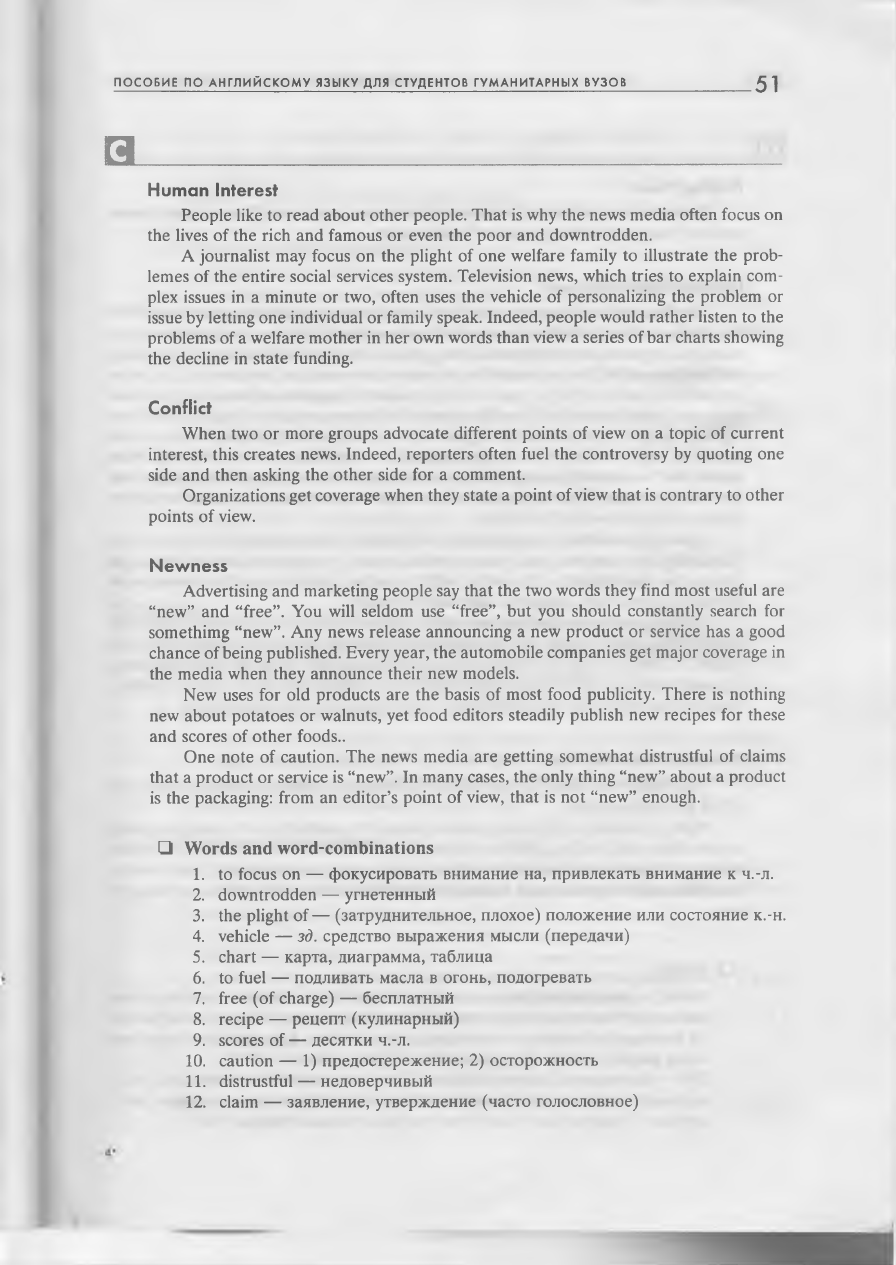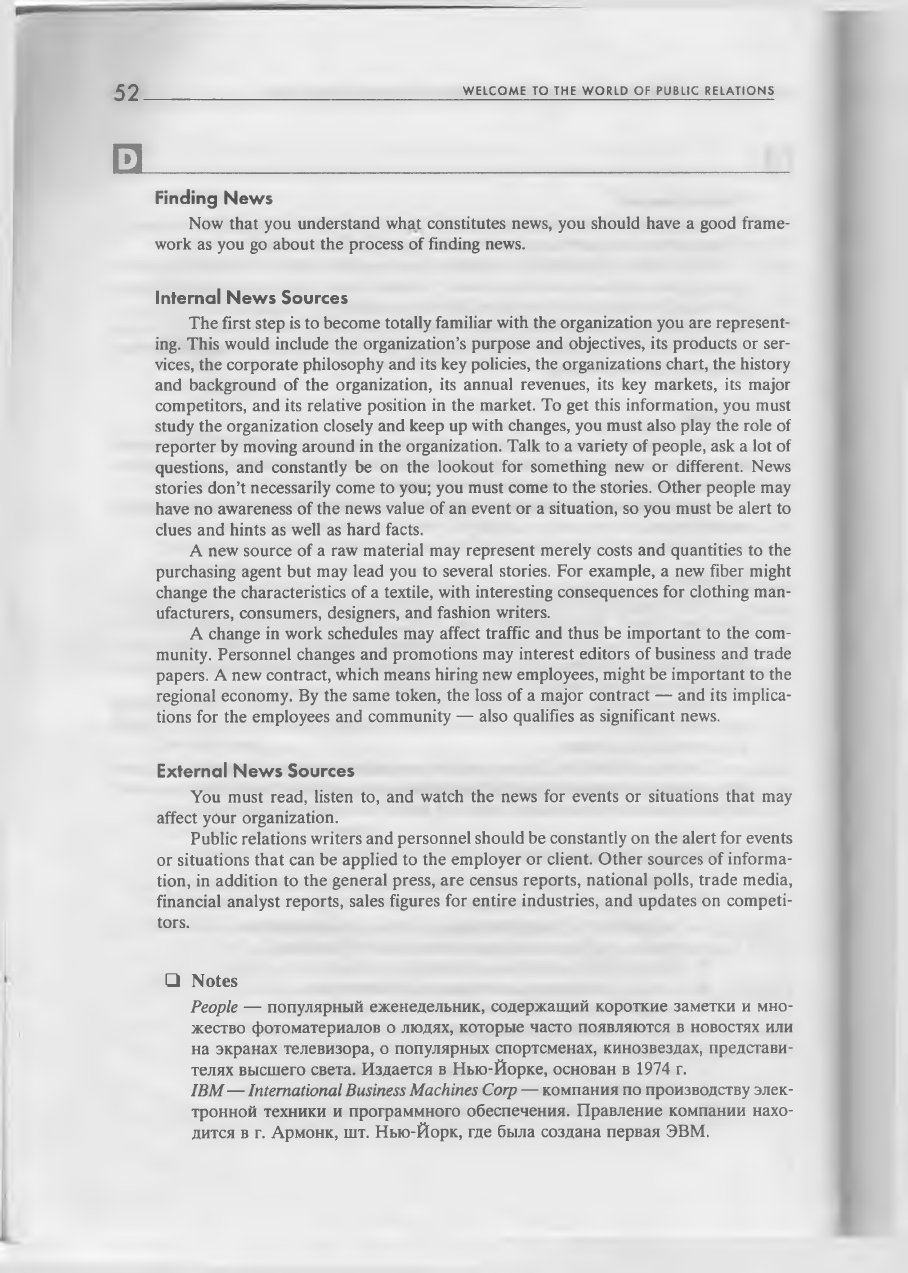ВУЗ: Не указан
Категория: Не указан
Дисциплина: Не указана
Добавлен: 01.04.2021
Просмотров: 1552
Скачиваний: 7

48
W E L C O M E TO THE W O R L D O F PUBLI C R E L A T I O N S
4) The purpose.......... media coverage, ...........an organization’s standpoint,
goes......... just news and information.
5) The material is handled......... the advertising or sales department......... the
newspaper or broadcast station.
11. Explain the following statements:
1) In many cases, publicity is strongly marketing oriented and designed to
generate sales.
2) The recession in the early 1990s left many publications scrambling for
advertising dollars, which directly affected the news space available.
3) Our society is experiencing widespread information clutter.
4) D on’t try to blanket the media with a blizzard of news items.
12. There are 4 points in the text that a public relation writer must keep in mind
to make his effort more effective.
Do you agree with them? Illustrate your point of view.
13. Develop the following statements:
1) A major objective of many public relations programs is to get publicity for the
employer or the client.
2) Placing news and information (publicity) in the news media should be done
with the objective of helping the organization achieve its goals.
3) Publicity is difficult to achieve. There is a great deal of competition for available
news space.
U N I T
TWO
What Makes News
Students in news-writing classes are taught the basic components of what consti
tutes “news”. Public relations writers, or publicists, must also be familiar with these
components if they are to generate the kind of information that appeals to media
gatekeepers. Aspects of news include timeliness, prominence, proximity, significance,
unusualness, human interest, conflict, and newness.
Timeliness
Timeliness may be the most important characteristic of news. By definition, news
must be current and timely.
One way to make news timely is to announce something when it happens. A
company usually contacts the press as soon as an event occurs — the issuing of the

П О С О Б И Е П О А Н Г Л И Й С К О М У Я З Ы К У Д Л Я С Т У Д Е Н Т О В Г У М А Н И Т А Р Н Ы Х В У З О В
49
quarterly earning report, the appointment of a key executive, the layoff of workers.
Any delay in conveying this information to the news media runs the risk of being
rejected as “old news”.
Another aspect of timeliness is offering information within the context of events
and issues that are already on the public agenda. Auto club and insurance companies,
for example, have excellent placement success with articles about safe driving just be
fore a long holiday weekend. Because Christmas-time is the major season for purchas
ing children’s toys, the media are receptive to news releases from manufacturers about
new toys on the market and what kinds of toys are setting sales records. Consumer
groups also use the context of Christmas to issue warnings about the safety of some
toys.
Prominence
The news media rarely cover the grand opening of a store unless a celebrity is
involved.
Another way of looking at prominence is to remember that “names make news”.
People are interested in other people, particularly if they are prominent or known in
some way. The success of
People
magazine proves the point.
Although the media are invariably attracted to the presence of movie stars, rock
stars, and pro athletes at an event, other types of prominent people also make news.
Note that prominence is not restricted to people; it extends also to organizations.
Large multinational corporations like IBM or Exxon automatically get more media
attention because they control so many resources and affect so many lives. If you work
for a smaller, less prominent company, you will have to try much harder to get media
coverage.
□ Words and word-combinations
1. to constitute news — составить (построить) новости
2. to generate information — производить, подавать информацию
3. to appeal to — привлекать, притягивать; нравиться
4. timeliness — своевременность
5. prominence — известность; значительность
6. proximity — близость, доступность
7. significance — важность, значительность
8. human interest — интерес широкой публики
9. newness — новизна
10. to issue — издавать, выпускать, опубликовать
11. quarterly earnings — заработки за квартал
12. a key executive — важное лицо в правительстве (государстве) или в руко
водстве фирмы
13. layoff — увольнение
14. to convey — передавать
15. to be on the agenda — быть включенным в повестку дня
16. placement — размещение
17. to set sales records — установить рекорд продаж
18. to cover an event — освещать событие
19. to get coverage — получить освещение в прессе и других средствах массо
вой информации
4-1962

W E L C O M E TO THE W O R L D O F PUBL I C R E L A T I O N S
Proximity
Surveys have shown that the news releases most acceptable to media gatekeepers
are those with a local angle. These stories are custom tailored for an organization or an
individual’s local newspaper. Typically, the local angle is in the lead and top half of the
release.
Obviously, the local angle — proximity — has strong news value. Whenever pos
sible, it is important to “localize” information. Publicists should take the time and extra
effort to tailor national information by including the names of local dealers, retailors,
and other area representatives for the news media serving a particular city or the
surrounding area.
Significance
If a situation or an event is likely to affect a substantial number of people, it is
significant. An increase in the price of heating oil is significant in the Northeast, where
many homes are heated by oil. However, this news is not very significant in the West,
where most homes are heated by gas. However, an increase in the price of gasoline
receives a great deal of local, regional, and national coverage because it affects almost
every family.
In judging significance, you must know not only the numbers of people affected but
also who will be affected. A requirement that filling stations install equipment to reduce
the amount of gasoline vaporized into the atmosphere was of minor interest to the
public, but it was extremely significant to the oil companies and service station owners
because of added costs. Consequently, the general press gave the new requirement a
few paragraphs, whereas it received extensive coverage in oil industry publications.
Unusualness
Anything out of the ordinary normally attracts press interest and public attention.
Activist groups like Greenpeace and animal rights advocates often generate news cov
erage by staging demonstrations with protesters wearing animal costumes or conduct
ing a mock funeral procession.
Unusual events and situations are often created solely for the sake of publicity.
□ Words and word-combinations
1. to tailor stories for smb — приспосабливать, обрабатывать информацию
2. to be in the lead — газетная информация, помещенная на видном месте;
наиболее важная информация (в последних известиях)
3. to be in the top half of the release — информация, помещенная в верхней
части первой страницы газеты
4. to receive local, regional, national, major extensive coverage — получить
освещение в местном (региональном, общенациональном) масштабе;
получить широкое освещение
5. added costs — добавочная стоимость

П О С О Б И Е П О А Н Г Л И Й С К О М У Я З Ы К У Д Л Я С Т У Д Е Н Т О В Г У М А Н И Т А Р Н Ы Х В У З О В
51
О
______________________________________________________________________________________
Human Interest
People like to read about other people. That is why the news media often focus on
the lives of the rich and famous or even the poor and downtrodden.
A journalist may focus on the plight of one welfare family to illustrate the prob-
lemes of the entire social services system. Television news, which tries to explain com
plex issues in a minute or two, often uses the vehicle of personalizing the problem or
issue by letting one individual or family speak. Indeed, people would rather listen to the
problems of a welfare mother in her own words than view a series of bar charts showing
the decline in state funding.
Conflict
When two or more groups advocate different points of view on a topic of current
interest, this creates news. Indeed, reporters often fuel the controversy by quoting one
side and then asking the other side for a comment.
Organizations get coverage when they state a point of view that is contrary to other
points of view.
Newness
Advertising and marketing people say that the two words they find most useful are
“new” and “free”. You will seldom use “free”, but you should constantly search for
somethimg “new”. Any news release announcing a new product or service has a good
chance of being published. Every year, the automobile companies get major coverage in
the media when they announce their new models.
New uses for old products are the basis of most food publicity. There is nothing
new about potatoes or walnuts, yet food editors steadily publish new recipes for these
and scores of other foods..
One note of caution. The news media are getting somewhat distrustful of claims
that a product or service is “new”. In many cases, the only thing “new” about a product
is the packaging: from an editor’s point of view, that is not “new” enough.
□ Words and word-combinations
1. to focus on — фокусировать внимание на, привлекать внимание к ч.-л.
2. downtrodden — угнетенный
3. the plight of — (затруднительное, плохое) положение или состояние к.-н.
4. vehicle —
зд.
средство выражения мысли (передачи)
5. chart — карта, диаграмма, таблица
6. to fuel — подливать масла в огонь, подогревать
7. free (of charge) — бесплатный
8. recipe — рецепт (кулинарный)
9. scores of — десятки ч.-л.
10. caution — 1) предостережение; 2) осторожность
11. distrustful — недоверчивый
12. claim — заявление, утверждение (часто голословное)

52
W E L C O M E T O T H E W O R L D O F P U B L I C R E L A T I O N S
□
______________________________________________________________________________________
Finding News
Now that you understand what constitutes news, you should have a good frame
work as you go about the process of finding news.
Internal News Sources
The first step is to become totally familiar with the organization you are represent
ing. This would include the organization’s purpose and objectives, its products or ser
vices, the corporate philosophy and its key policies, the organizations chart, the history
and background of the organization, its annual revenues, its key markets, its major
competitors, and its relative position in the market. To get this information, you must
study the organization closely and keep up with changes, you must also play the role of
reporter by moving around in the organization. Talk to a variety of people, ask a lot of
questions, and constantly be on the lookout for something new or different. News
stories don’t necessarily come to you; you must come to the stories. Other people may
have no awareness of the news value of an event or a situation, so you must be alert to
clues and hints as well as hard facts.
A new source of a raw material may represent merely costs and quantities to the
purchasing agent but may lead you to several stories. For example, a new fiber might
change the characteristics of a textile, with interesting consequences for clothing man
ufacturers, consumers, designers, and fashion writers.
A change in work schedules may affect traffic and thus be important to the com
munity. Personnel changes and promotions may interest editors of business and trade
papers. A new contract, which means hiring new employees, might be important to the
regional economy. By the same token, the loss of a major contract — and its implica
tions for the employees and community — also qualifies as significant news.
External News Sources
You must read, listen to, and watch the news for events or situations that may
affect your organization.
Public relations writers and personnel should be constantly on the alert for events
or situations that can be applied to the employer or client. Other sources of informa
tion, in addition to the general press, are census reports, national polls, trade media,
financial analyst reports, sales figures for entire industries, and updates on competi
tors.
□ Notes
People
— популярный еженедельник, содержащий короткие заметки и мно
жество фотоматериалов о людях, которые часто появляются в новостях или
на экранах телевизора, о популярных спортсменах, кинозвездах, представи
телях высшего света. Издается в Нью-Йорке, основан в 1974 г.
IB M — International Business Machines Corp
— компания по производству элек
тронной техники и программного обеспечения. Правление компании нахо
дится в г. Армонк, шт. Нью-Йорк, где была создана первая ЭВМ.